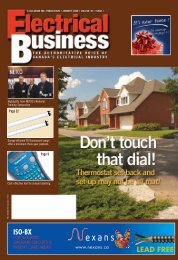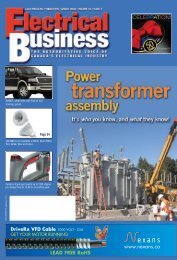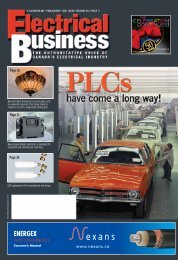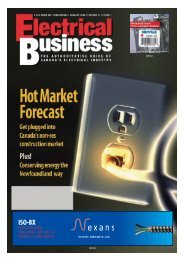Page 27 Page 32 Page 17 - Electrical Business Magazine
Page 27 Page 32 Page 17 - Electrical Business Magazine
Page 27 Page 32 Page 17 - Electrical Business Magazine
- No tags were found...
You also want an ePaper? Increase the reach of your titles
YUMPU automatically turns print PDFs into web optimized ePapers that Google loves.
Protecting your powerSpecifying outdoor generator enclosuresBy James IversonAs businesses and industries add more andlarger emergency standby generators to reducethe impact of power outages, deciding whereto locate these gensets can be problematic. Standalonebuildings or large mechanical rooms arenot an option in many applications, particularlyexisting facilities or other sites with limited spaceor other installation obstacles. Outdoor generatorenclosures are the answer in these situations, andas emergency standby generators have becomemore vital to the continuation of business so, too,have outdoor genset enclosures that are properlydesigned, ventilated, secured and located.Once the decision has been made to install thegenset out in an enclosure, the overall cost and easeof installation will depend on the physical locationof all elements of the system: genset, fuel tanks andaccessories. Several types of enclosures are available,including weather-protective, sound-attenuatingand walk-in.Weather-protective: While metal enclosures provideweather protection against the elements,they do not retain heat or hold temperaturesabove ambient in cold weather, or provide coolingbeyond the ventilation and airflow offered byincorporated louvers or perforated panels. Soundattenuation is minimal and, due to their tight fit,access panels or doors are required for maintenanceand inspections.Sound-attenuating: These enclosures may be specifiedwhen noise reduction is needed to meet localordinances. They are generally larger and more costlythan strictly weather-protective enclosures due tothe design features required to reduce noise.Walk-in: This term encompasses a variety of enclosuresthat are custom-built to a specific application.They often include sound attenuation, as well asspace for power switching and monitoring equipment,lighting, fuel tanks and other equipment.They can also accommodate insulating and heatingcapability. Walk-in enclosures may be treated as abuilding by local inspection officials.enclosures so that the heat from one generator is not drawninto others.Sometimes, as a last resort, the only outdoor location foran enclosed genset may be the rooftop. Provided the roof isproperly designed or modified to take the extra weight, this canoften be a solution in urban areas. However, there are advantagesand disadvantages. While this location may resolve spacelimitations, refuelling, load bank testing and maintenance maybe more difficult.All-weather protectionThe amount of weather protection needed is often a matter ofgeography. In tropical climates, the principal weather challengesare sun, heat, rain, salt spray, wind storms, blowing sand andlightning. Within 60 miles of the ocean, aluminum enclosuresresist corrosion from salt air. In more northern climates, icestorms, heavy snow and severe cold pose additional threats.It is recommended that any outdoor genset enclosure havea corrosion-resistant finish (often aluminum or painted steel),Outdoor enclosure criteriaVirtually any genset size can be housed in anoutdoor enclosure available from the generatorsupplier or a variety of third-party suppliers. Whenyour facility is considering a new generator thatwill be housed in an outdoor enclosure, you shouldconsider the criteria that follow.Site selectionThe location for your outdoor enclosure should belevel, well-drained and secure from flooding, fire,icing and vandalism. For reasons of reliability, thegenset should be located near the main electricalservice but not so close that localized problemsat the service entrance will interfere with it. Forexample, a fire at the utility service entrance wouldbe less likely to affect a standby genset located somedistance away. Control panels and connectionsshould have ample clearance for easy access, andthe fuel tank should be located so that refuelling isconvenient. Also, keep the generator location awayfrom building openings, combustible materials orbuilding ventilation inlets.In multiple-generator applications, be sure thereis adequate spacing between generators. Orient theRugged and reliableelectrical testing products.All in the Fluke family.Earth groundclamp metersCurrent leakageclamp meters<strong>Electrical</strong> testersInsulation testersDon’t get burned.Find it. Fix it. Fast.The new Fluke T+PRO electrical testershave all the benefits of a solenoid testerwith the safety of a CAT IV 600V rating.Low impedance means no ghost voltagescausing false measurements.• Measure continuity, resistance and GFCI trip• Voltage detection and basic measurementwork even with dead batteries• Audible, visual, vibration indication• Integrated rotary field indicatorFor more information call 800-36-FLUKEor visit www.flukecanada.ca/burnedFluke. Keeping your worldup and running.NEWINFO NO. 20www. mag.com • NOVEMBER/DECEMBER 2007 • <strong>17</strong>
















